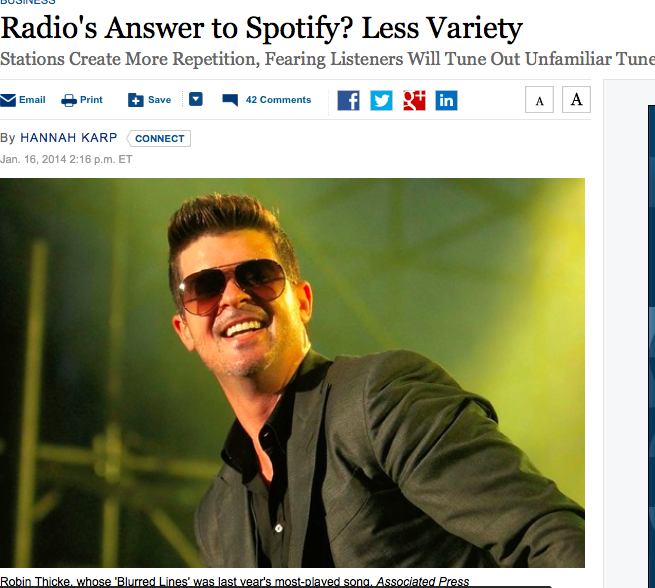 |
| The Wall Street Journal is reporting that radio stations are changing programming in response to streaming services. |
If a recent article in the Wall Street Journal is any indication, our exposure to music through the radio is becoming more and more narrowly focused. It’s all in response to the explosion of digital services, the Wall Street Journal argues. Radio stations, they contend are “…more reluctant than ever to pull well-known hits from their rotations, extending the trim artists must wait to introduce new songs.” The WSJ article entitled, “Radio’s Answer to Spotify? Less Variety”.
Citing statistics from Metabase, which tracks the songs played through broadcasts, the top 10 songs last year were played almost twice as much on the radio than 10 years ago. Those numbers should be put against another statistic from Nielsen research that shows most people discover new music through old fashioned radio.
Personally speaking, digital music has altered my listening habits but I wonder to what degree. Let’s look at a few anecdotal examples and you can compare to your own experience:
- Passive Listening: I define passive listening as an experience with minimal control, like the Radio. Sure, I can tune into a station that normally plays a consistent genre, but once you’re dialed into that genre, all bets are off.
- User-Controlled Listening: I define user-controlled listening as listening to content I control. Vinyl, cassettes, CDs, digital audio are to me all user-controlled listening experiences. I chose what band. I control the order of the songs. I determine exactly the genre and even sub-genre and mix the music I want, etc. I either have control or the potential of direct control.
- Hybrid Listening: I think that there’s now a hybrid category here. Radio started the trend with things like playing a series of Led Zepplin cuts at a particular time and day but it was really Satellite radio that took it to another level popularized it by making specific stations based on an artist (Pink Floyd Channel) or date (Hits from 1984). These channels were available all the time, anytime.
Now I want to take it one step further. Passive Listening for me has always been something predicated by my location. I listen to the radio predominantly in my car and rarely at home. When I was younger, sure, I would sometime listen to the radio at home when doing homework but as I reflect on it, I think I always tended towards user-controlled listening sessions. The mediums were different, but the habit was the same.
If I extrapolate out several anecdotal examples, I see the forms changing (vinyl, cassette tape, CD, digital music) but I don’t see my habits radically changing. Even now, with the advent of Pandora or iTunes Radio, I haven’t noticed a particular shift in the way I listen to music.
So I’m wondering about the premise and interpretation of the data the article. If radio station musical offerings are becoming less diverse, then is this strategy retaining listeners? Is the advent of streaming services simply amplifying existing tenancies of listeners? Should radio stations look to a hybrid business model in the long run or should streaming services look to a hybrid model whereby there is both a passive listening experience as well as the opportunity to tune into a hybrid or more controlled listening experience?
For example, if a radio station follows along its more traditional paths, can’t it also launch an app and play out channels from its music catalog? Why prevents a local radio station from offering both its live programming and specific channels? If I’m radio station WXYZ and I’m a rock-n-roll oriented station, why can’t I also stream out Pink Floyd, Van Halen, Guns-n-Roses, etc. as additional channels. Advertising, revenue, and more could potentially follow such a model.
There’s no question that digital audio and in particular mobile devices are affecting listening. At the end of the day, I simply wonder if these devices are simply tapping providing listeners to tap into their preferences anywhere, anytime as opposed to creating new habits. If that’s the case, then is the reaction of certain radio stations a wrong move based on a bad interpretation of the data.











